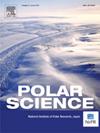Similarities and differences in circulation beneath the Filchner- Ronne and Ross Ice Shelves: A Lagrangian point of view
IF 2
4区 地球科学
Q3 ECOLOGY
引用次数: 0
Abstract
We compared circulations under the Filchner-Ronne Ice Shelf (FRIS) and the Ross Ice Shelf (RIS) using output from the Whole Antarctica Ocean Model driven by repeated year atmospheric forcing and processed by the particle-tracking Parcels model. Three Lagrangian characteristics were calculated: the visitation frequency, the mean age, and the representative particle trajectory. In both FRIS and RIS, the High Salinity Shelf Water (HSSW) entered through depressions off the western coast of ice shelves. We found that HSSW transformed into the Ice Shelf Water that departed both ice shelves at central ice front locations (approximately 58-57°W in Ronne Ice Shelf and 175°W in RIS). The outflow through the Ronne Ice Front we identified has not attracted attention until now, although it has been observed. Almost half of the particles departed FRIS through the Ronne Ice Front, whereas about 20% stayed under FRIS. The rest of the particles flow out through the Filchner Trough. In contrast, only 2% of the particles stayed under RIS. The mean age of water leaving FRIS through the Ronne Ice Front and the water leaving RIS was 7–8 years, whereas the water leaving FRIS through the Filchner Trough was about 10 years.
费尔奇纳-罗纳和罗斯冰架下环流的异同:拉格朗日的观点
我们利用由重复年度大气强迫驱动并经过粒子跟踪包裹模式处理的整个南极洲海洋模式的输出,比较了Filchner-Ronne冰架(FRIS)和Ross冰架(RIS)下的环流。计算了三个拉格朗日特征:访问频率、平均年龄和代表性粒子轨迹。在FRIS和RIS中,高盐度陆架水(HSSW)都是通过冰架西海岸的洼地进入的。我们发现,在中心冰锋位置(Ronne冰架约为58-57°W, RIS冰架约为175°W), HSSW转化为冰架水,离开两个冰架。我们发现的通过罗纳冰锋的外流直到现在才引起人们的注意,尽管它已经被观察到。几乎一半的颗粒通过Ronne冰锋离开FRIS,而大约20%留在FRIS之下。其余的颗粒通过费尔奇纳槽流出。相比之下,只有2%的颗粒留在RIS下。通过Ronne冰锋和离开RIS的水平均年龄为7 ~ 8年,而通过Filchner槽离开FRIS的水平均年龄约为10年。
本文章由计算机程序翻译,如有差异,请以英文原文为准。
求助全文
约1分钟内获得全文
求助全文
来源期刊

Polar Science
ECOLOGY-GEOSCIENCES, MULTIDISCIPLINARY
CiteScore
3.90
自引率
5.60%
发文量
46
期刊介绍:
Polar Science is an international, peer-reviewed quarterly journal. It is dedicated to publishing original research articles for sciences relating to the polar regions of the Earth and other planets. Polar Science aims to cover 15 disciplines which are listed below; they cover most aspects of physical sciences, geosciences and life sciences, together with engineering and social sciences. Articles should attract the interest of broad polar science communities, and not be limited to the interests of those who work under specific research subjects. Polar Science also has an Open Archive whereby published articles are made freely available from ScienceDirect after an embargo period of 24 months from the date of publication.
- Space and upper atmosphere physics
- Atmospheric science/climatology
- Glaciology
- Oceanography/sea ice studies
- Geology/petrology
- Solid earth geophysics/seismology
- Marine Earth science
- Geomorphology/Cenozoic-Quaternary geology
- Meteoritics
- Terrestrial biology
- Marine biology
- Animal ecology
- Environment
- Polar Engineering
- Humanities and social sciences.
 求助内容:
求助内容: 应助结果提醒方式:
应助结果提醒方式:


